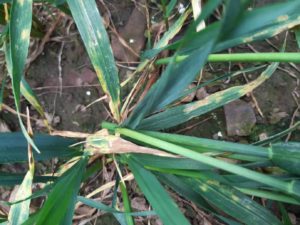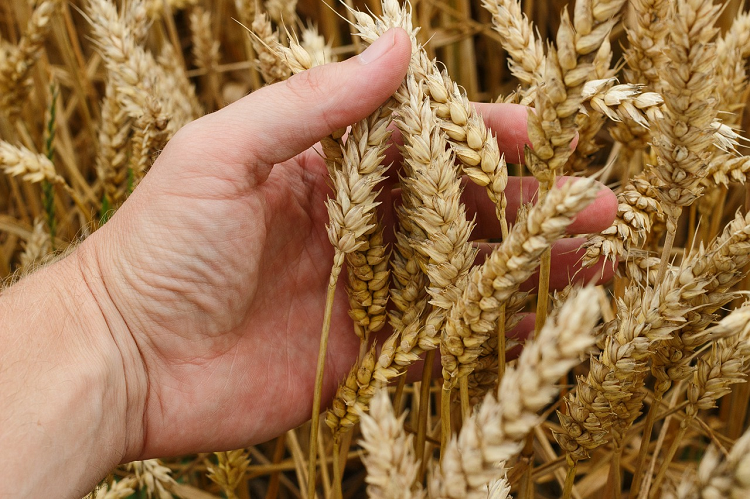Keeping a lid on winter wheat disease risks
20 April 2022Winter wheat crops are commonly more advanced than usual this season, as a consequence of early drilling and benign winter conditions. The flag leaf is emerging earlier than expected for some people and this is the most important of the fungicide timings to get right in order to manage disease in the crop. Winter wheat crops established well and have looked good all season and managing them to their full potential is the aim. Disease has been detectable from early in the season but the dry period in March and April has been helpful and yellow rust and septoria have not taken off as speedily as they might have done.

Septoria is confined to the lower leaves even in untreated trial plots in more resistant varieties like RGT Saki
Septoria pressure of course will build from now on in, driven by temperature and rainfall. Until now in SRUC trials the highest levels of wheat disease has been in early drilled plots with differences between varieties to date pretty small. But the benefits of higher septoria scores start to become more and more noticeable from this point in the season on. Already in trials we begin to see higher scoring varieties like RGT Saki (6.5) looking cleaner than lower scoring varieties like Elation at 4.1, although in both cases setoria is still nicely confined to the lower leaver. Earlier fungicide applications seem to have worked well and treated plots are only carrying traces of Septoria. Worth noting that mildew levels in untreated plots are high, and yellow rust is easy to find in plots of low scoring rust varieties such as LG Spotlight. We are also noting higher than usual levels of eyespot.
The treatment timing for eyespot is past but it is worth checking the cause of any whiteheads and low yielding patches in field if you see them, so that eyespot risk can be factored in to future crop management plans. The varieties on the current recommended list are all pretty weak for eyespot with a lot of 3s and 4s. Only Revelation with a ‘7’ score is slightly more resilient to this disease.
Because the flag leaf is such a key timing to get right, best advice is to utilise the most effective active ingredients at this timing. Septoria has a history of eroding the efficacy of azoles and there are emerging resistance issues in SDHIs. The withdrawal of chlorothalonil means the other chemistry is having to carry more of the disease management load, hence the move to the most effective of the available options at the flag leaf. The addition of the multisite folpet is helpful in adding to disease management and also in terms of resistance management in the azoles and SDHIs. Effective SDHI and azole options from AHDB and SRUC trials are Revystar XE and Ascra Xpro. These trials also show that another very effective option is Univoq which has a new mode of action ‘fenpicoxamide’ in mix with the established azole prothiconazole. This gives an excellent opportunity to reduce the resistance pressure on the SDHI chemistry.
The next spray to consider will be ear sprays and good timing is key a sprays need to be applied to the ear within days of an infection event. By late flowering the diseases can be too well established to be well managed. We are reliant on azole fungicides at the timing and, in addition to ear disease, they will also help to manage existing foliar disease and retain green leaf to drive grain filling. Wet weather over flowering and grain filling increases the chance of ear disease and with it the risk of mycotoxins. Treatment helps to reduce the risk score and all wheat crop must have been mycotoxin risk scored before going in to the food chain. Grain will also need a grain passport so make sure you have booked in for an audit with SQC assurance scheme if you haven’t already had one this year so that passports can be issued in good time. You can arrange this yourself by emailing sqc-ca@lr.org.”
Fiona Burnett – SRUC, for the Farm Advisory Service
Sign up to the FAS newsletter
Receive updates on news, events and publications from Scotland’s Farm Advisory Service

